Business Research Methods (MHC607): Training Impact on Retention
VerifiedAdded on 2023/06/15
|7
|1611
|336
Report
AI Summary
This report investigates the impact of training on employee retention within the hospitality sector, employing a qualitative research methodology. The research utilizes an inductive approach, reviewing existing literature and examining employee behavior to establish a relationship between training (independent variable) and retention (dependent variable). Data is collected through a structured interview with an employee, and analyzed using qualitative data analysis techniques, including axial coding. Ethical considerations are addressed to ensure participant dignity and data confidentiality. The study acknowledges limitations such as a small sample size (one employee) and potential interviewer bias, which may affect the generalizability and reliability of the findings. Despite these limitations, the research aims to provide insights into how training initiatives can contribute to improved employee retention strategies, highlighting the importance of ethical research practices and awareness of potential biases in data collection and analysis. This report is contributed by a student and available on Desklib, where students can find similar solved assignments and past papers.
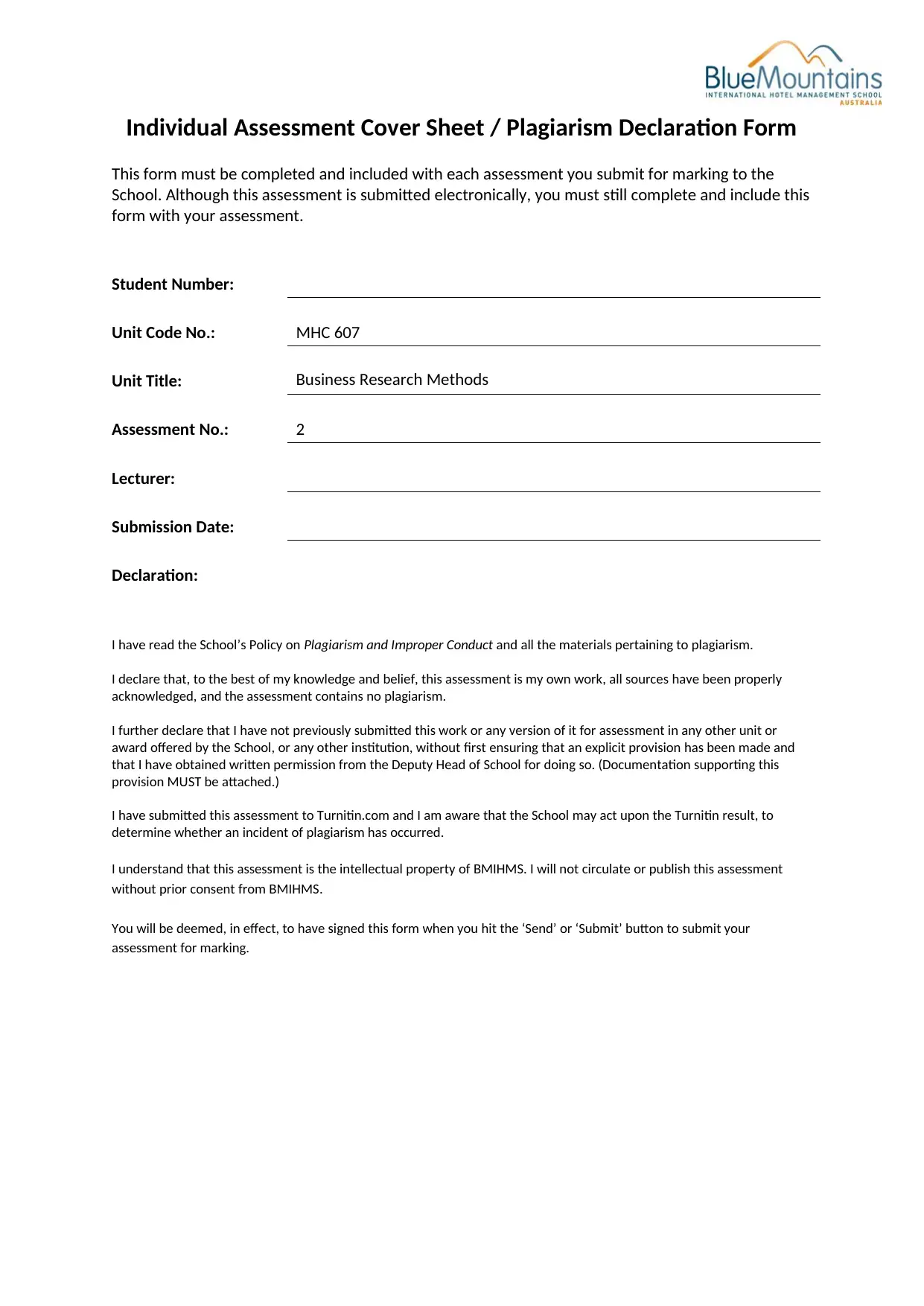
Individual Assessment Cover Sheet / Plagiarism Declaration Form
This form must be completed and included with each assessment you submit for marking to the
School. Although this assessment is submitted electronically, you must still complete and include this
form with your assessment.
Student Number:
Unit Code No.: MHC 607
Unit Title: Business Research Methods
Assessment No.: 2
Lecturer:
Submission Date:
Declaration:
I have read the School’s Policy on Plagiarism and Improper Conduct and all the materials pertaining to plagiarism.
I declare that, to the best of my knowledge and belief, this assessment is my own work, all sources have been properly
acknowledged, and the assessment contains no plagiarism.
I further declare that I have not previously submitted this work or any version of it for assessment in any other unit or
award offered by the School, or any other institution, without first ensuring that an explicit provision has been made and
that I have obtained written permission from the Deputy Head of School for doing so. (Documentation supporting this
provision MUST be attached.)
I have submitted this assessment to Turnitin.com and I am aware that the School may act upon the Turnitin result, to
determine whether an incident of plagiarism has occurred.
I understand that this assessment is the intellectual property of BMIHMS. I will not circulate or publish this assessment
without prior consent from BMIHMS.
You will be deemed, in effect, to have signed this form when you hit the ‘Send’ or ‘Submit’ button to submit your
assessment for marking.
This form must be completed and included with each assessment you submit for marking to the
School. Although this assessment is submitted electronically, you must still complete and include this
form with your assessment.
Student Number:
Unit Code No.: MHC 607
Unit Title: Business Research Methods
Assessment No.: 2
Lecturer:
Submission Date:
Declaration:
I have read the School’s Policy on Plagiarism and Improper Conduct and all the materials pertaining to plagiarism.
I declare that, to the best of my knowledge and belief, this assessment is my own work, all sources have been properly
acknowledged, and the assessment contains no plagiarism.
I further declare that I have not previously submitted this work or any version of it for assessment in any other unit or
award offered by the School, or any other institution, without first ensuring that an explicit provision has been made and
that I have obtained written permission from the Deputy Head of School for doing so. (Documentation supporting this
provision MUST be attached.)
I have submitted this assessment to Turnitin.com and I am aware that the School may act upon the Turnitin result, to
determine whether an incident of plagiarism has occurred.
I understand that this assessment is the intellectual property of BMIHMS. I will not circulate or publish this assessment
without prior consent from BMIHMS.
You will be deemed, in effect, to have signed this form when you hit the ‘Send’ or ‘Submit’ button to submit your
assessment for marking.
Paraphrase This Document
Need a fresh take? Get an instant paraphrase of this document with our AI Paraphraser
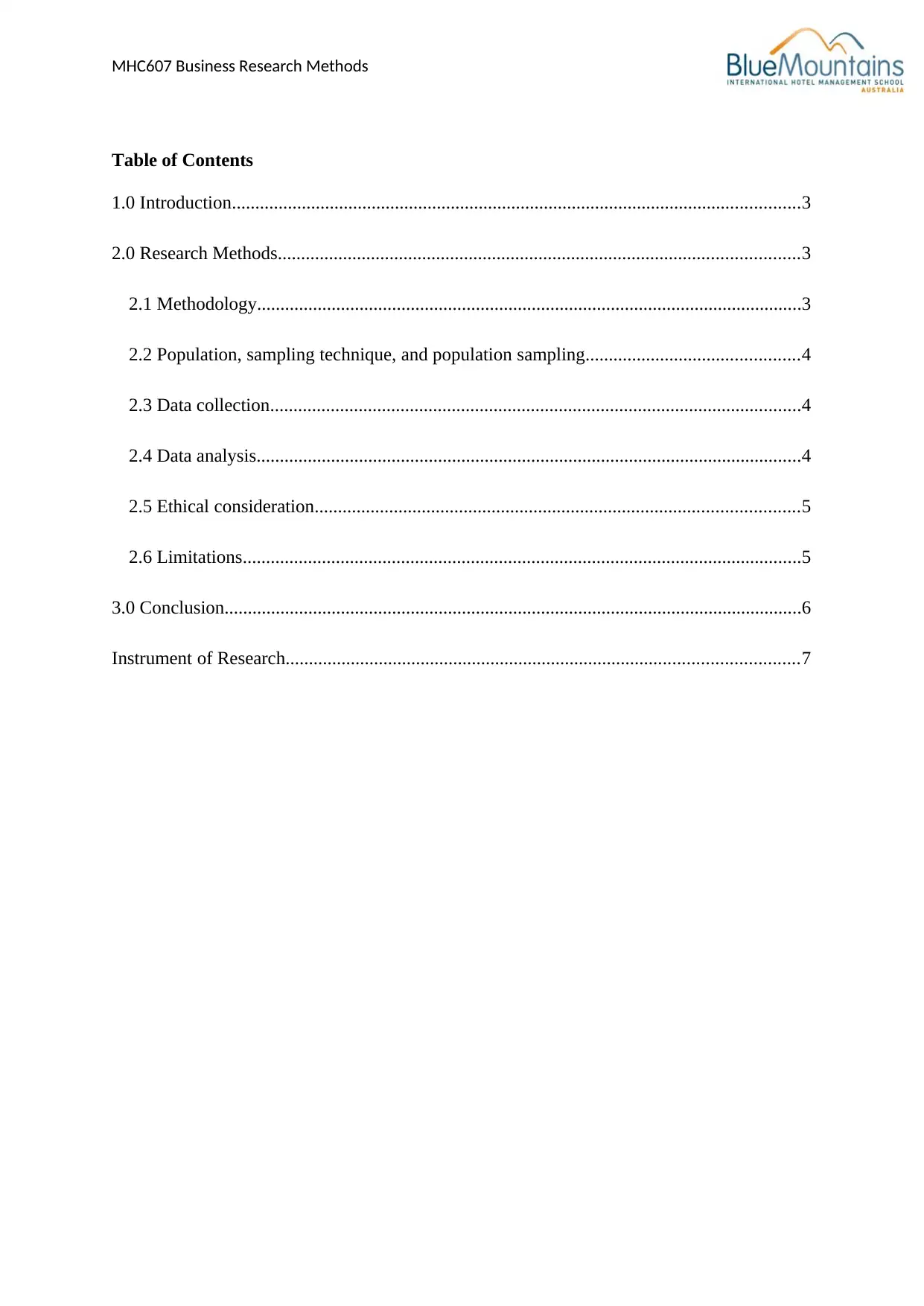
MHC607 Business Research Methods
Table of Contents
1.0 Introduction..........................................................................................................................3
2.0 Research Methods................................................................................................................3
2.1 Methodology.....................................................................................................................3
2.2 Population, sampling technique, and population sampling..............................................4
2.3 Data collection..................................................................................................................4
2.4 Data analysis.....................................................................................................................4
2.5 Ethical consideration........................................................................................................5
2.6 Limitations........................................................................................................................5
3.0 Conclusion............................................................................................................................6
Instrument of Research..............................................................................................................7
Table of Contents
1.0 Introduction..........................................................................................................................3
2.0 Research Methods................................................................................................................3
2.1 Methodology.....................................................................................................................3
2.2 Population, sampling technique, and population sampling..............................................4
2.3 Data collection..................................................................................................................4
2.4 Data analysis.....................................................................................................................4
2.5 Ethical consideration........................................................................................................5
2.6 Limitations........................................................................................................................5
3.0 Conclusion............................................................................................................................6
Instrument of Research..............................................................................................................7
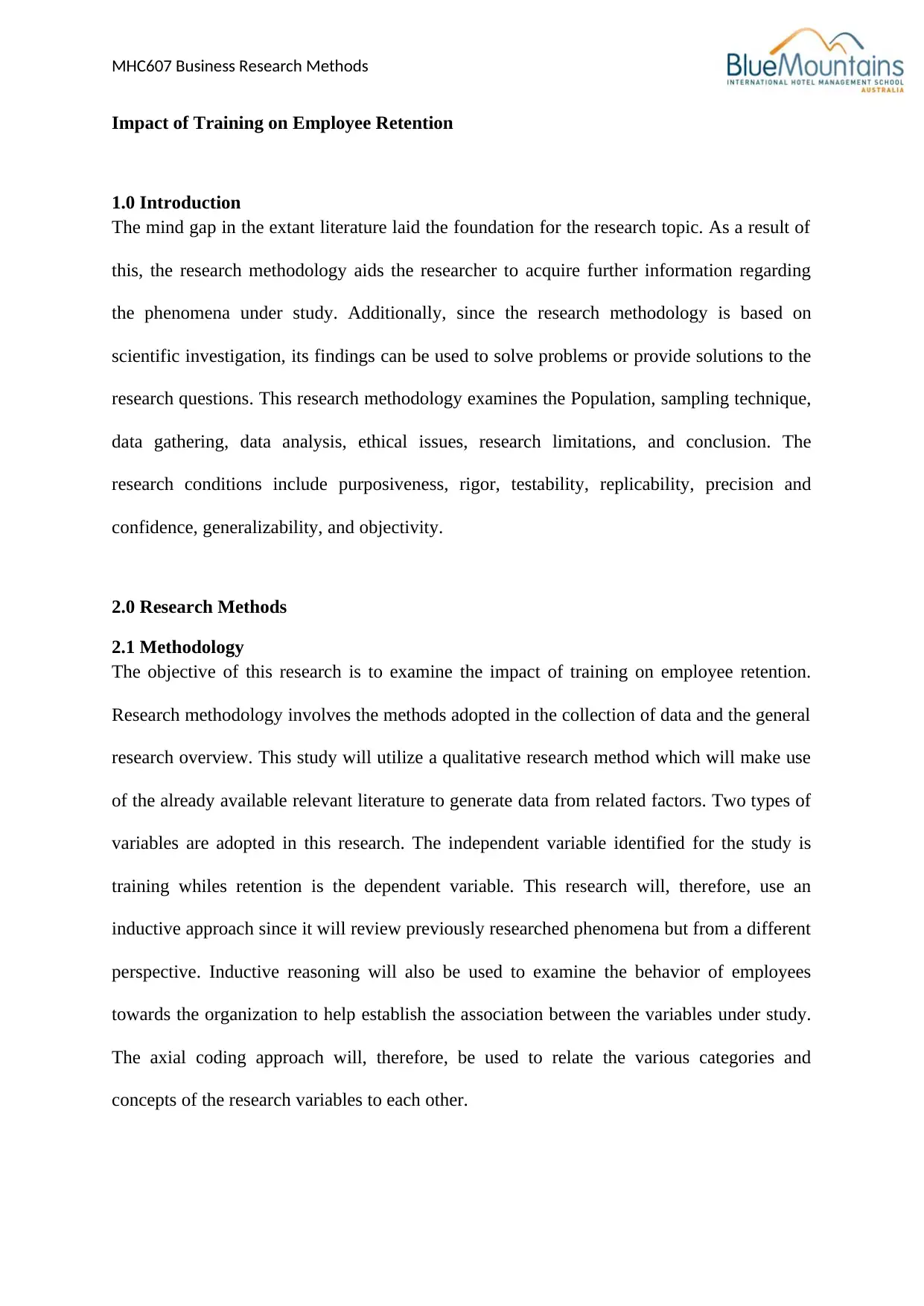
MHC607 Business Research Methods
Impact of Training on Employee Retention
1.0 Introduction
The mind gap in the extant literature laid the foundation for the research topic. As a result of
this, the research methodology aids the researcher to acquire further information regarding
the phenomena under study. Additionally, since the research methodology is based on
scientific investigation, its findings can be used to solve problems or provide solutions to the
research questions. This research methodology examines the Population, sampling technique,
data gathering, data analysis, ethical issues, research limitations, and conclusion. The
research conditions include purposiveness, rigor, testability, replicability, precision and
confidence, generalizability, and objectivity.
2.0 Research Methods
2.1 Methodology
The objective of this research is to examine the impact of training on employee retention.
Research methodology involves the methods adopted in the collection of data and the general
research overview. This study will utilize a qualitative research method which will make use
of the already available relevant literature to generate data from related factors. Two types of
variables are adopted in this research. The independent variable identified for the study is
training whiles retention is the dependent variable. This research will, therefore, use an
inductive approach since it will review previously researched phenomena but from a different
perspective. Inductive reasoning will also be used to examine the behavior of employees
towards the organization to help establish the association between the variables under study.
The axial coding approach will, therefore, be used to relate the various categories and
concepts of the research variables to each other.
Impact of Training on Employee Retention
1.0 Introduction
The mind gap in the extant literature laid the foundation for the research topic. As a result of
this, the research methodology aids the researcher to acquire further information regarding
the phenomena under study. Additionally, since the research methodology is based on
scientific investigation, its findings can be used to solve problems or provide solutions to the
research questions. This research methodology examines the Population, sampling technique,
data gathering, data analysis, ethical issues, research limitations, and conclusion. The
research conditions include purposiveness, rigor, testability, replicability, precision and
confidence, generalizability, and objectivity.
2.0 Research Methods
2.1 Methodology
The objective of this research is to examine the impact of training on employee retention.
Research methodology involves the methods adopted in the collection of data and the general
research overview. This study will utilize a qualitative research method which will make use
of the already available relevant literature to generate data from related factors. Two types of
variables are adopted in this research. The independent variable identified for the study is
training whiles retention is the dependent variable. This research will, therefore, use an
inductive approach since it will review previously researched phenomena but from a different
perspective. Inductive reasoning will also be used to examine the behavior of employees
towards the organization to help establish the association between the variables under study.
The axial coding approach will, therefore, be used to relate the various categories and
concepts of the research variables to each other.
⊘ This is a preview!⊘
Do you want full access?
Subscribe today to unlock all pages.

Trusted by 1+ million students worldwide
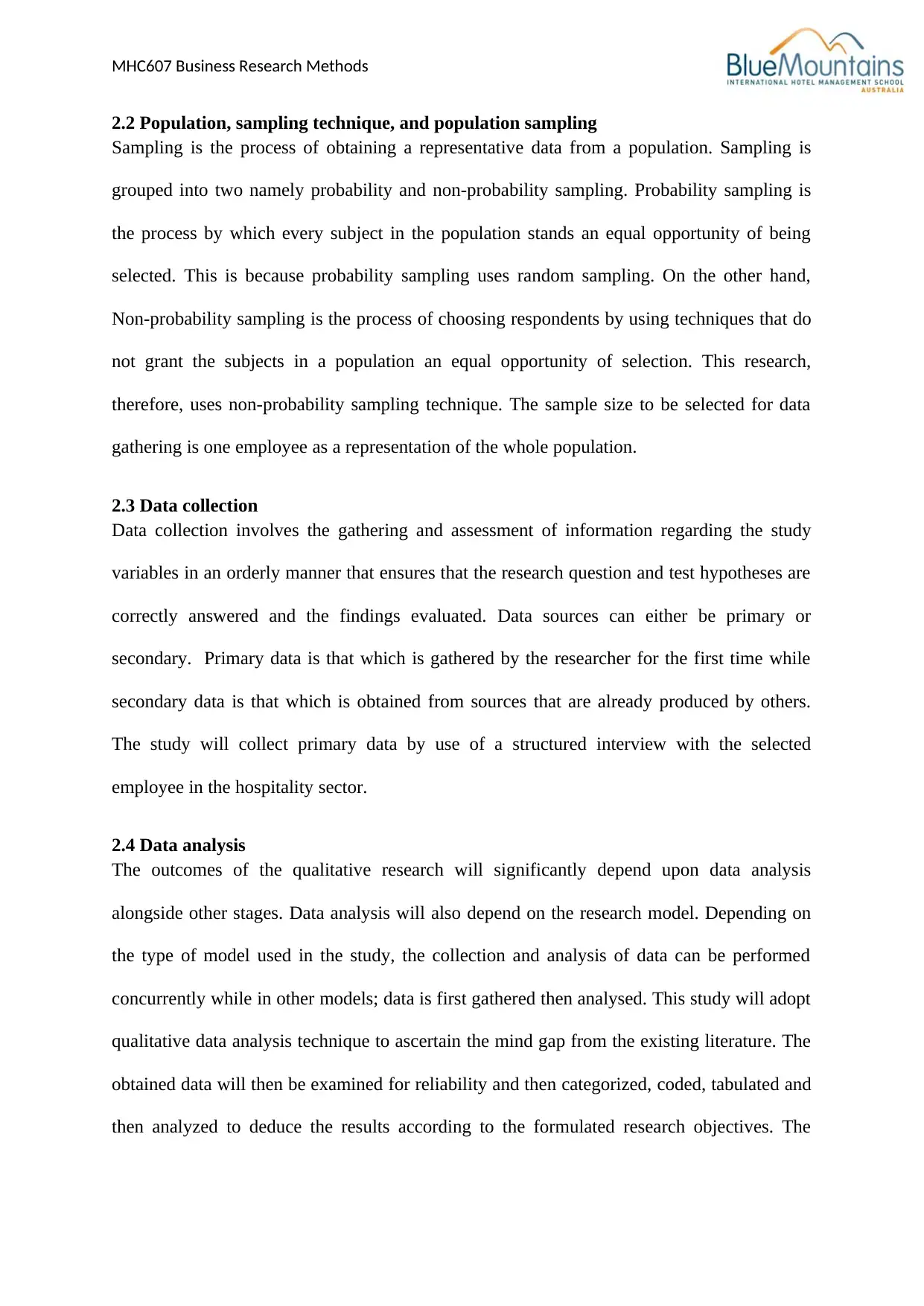
MHC607 Business Research Methods
2.2 Population, sampling technique, and population sampling
Sampling is the process of obtaining a representative data from a population. Sampling is
grouped into two namely probability and non-probability sampling. Probability sampling is
the process by which every subject in the population stands an equal opportunity of being
selected. This is because probability sampling uses random sampling. On the other hand,
Non-probability sampling is the process of choosing respondents by using techniques that do
not grant the subjects in a population an equal opportunity of selection. This research,
therefore, uses non-probability sampling technique. The sample size to be selected for data
gathering is one employee as a representation of the whole population.
2.3 Data collection
Data collection involves the gathering and assessment of information regarding the study
variables in an orderly manner that ensures that the research question and test hypotheses are
correctly answered and the findings evaluated. Data sources can either be primary or
secondary. Primary data is that which is gathered by the researcher for the first time while
secondary data is that which is obtained from sources that are already produced by others.
The study will collect primary data by use of a structured interview with the selected
employee in the hospitality sector.
2.4 Data analysis
The outcomes of the qualitative research will significantly depend upon data analysis
alongside other stages. Data analysis will also depend on the research model. Depending on
the type of model used in the study, the collection and analysis of data can be performed
concurrently while in other models; data is first gathered then analysed. This study will adopt
qualitative data analysis technique to ascertain the mind gap from the existing literature. The
obtained data will then be examined for reliability and then categorized, coded, tabulated and
then analyzed to deduce the results according to the formulated research objectives. The
2.2 Population, sampling technique, and population sampling
Sampling is the process of obtaining a representative data from a population. Sampling is
grouped into two namely probability and non-probability sampling. Probability sampling is
the process by which every subject in the population stands an equal opportunity of being
selected. This is because probability sampling uses random sampling. On the other hand,
Non-probability sampling is the process of choosing respondents by using techniques that do
not grant the subjects in a population an equal opportunity of selection. This research,
therefore, uses non-probability sampling technique. The sample size to be selected for data
gathering is one employee as a representation of the whole population.
2.3 Data collection
Data collection involves the gathering and assessment of information regarding the study
variables in an orderly manner that ensures that the research question and test hypotheses are
correctly answered and the findings evaluated. Data sources can either be primary or
secondary. Primary data is that which is gathered by the researcher for the first time while
secondary data is that which is obtained from sources that are already produced by others.
The study will collect primary data by use of a structured interview with the selected
employee in the hospitality sector.
2.4 Data analysis
The outcomes of the qualitative research will significantly depend upon data analysis
alongside other stages. Data analysis will also depend on the research model. Depending on
the type of model used in the study, the collection and analysis of data can be performed
concurrently while in other models; data is first gathered then analysed. This study will adopt
qualitative data analysis technique to ascertain the mind gap from the existing literature. The
obtained data will then be examined for reliability and then categorized, coded, tabulated and
then analyzed to deduce the results according to the formulated research objectives. The
Paraphrase This Document
Need a fresh take? Get an instant paraphrase of this document with our AI Paraphraser
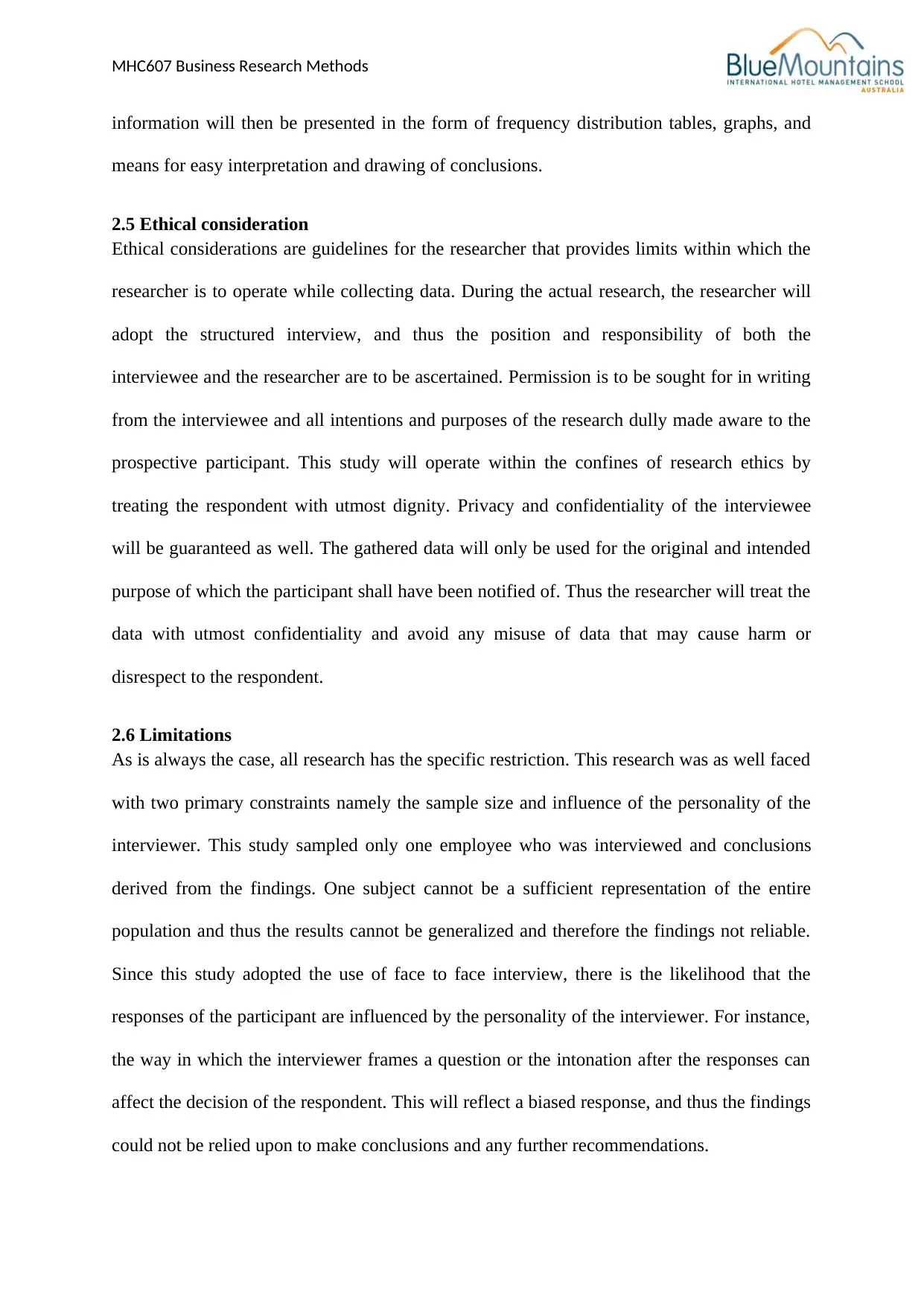
MHC607 Business Research Methods
information will then be presented in the form of frequency distribution tables, graphs, and
means for easy interpretation and drawing of conclusions.
2.5 Ethical consideration
Ethical considerations are guidelines for the researcher that provides limits within which the
researcher is to operate while collecting data. During the actual research, the researcher will
adopt the structured interview, and thus the position and responsibility of both the
interviewee and the researcher are to be ascertained. Permission is to be sought for in writing
from the interviewee and all intentions and purposes of the research dully made aware to the
prospective participant. This study will operate within the confines of research ethics by
treating the respondent with utmost dignity. Privacy and confidentiality of the interviewee
will be guaranteed as well. The gathered data will only be used for the original and intended
purpose of which the participant shall have been notified of. Thus the researcher will treat the
data with utmost confidentiality and avoid any misuse of data that may cause harm or
disrespect to the respondent.
2.6 Limitations
As is always the case, all research has the specific restriction. This research was as well faced
with two primary constraints namely the sample size and influence of the personality of the
interviewer. This study sampled only one employee who was interviewed and conclusions
derived from the findings. One subject cannot be a sufficient representation of the entire
population and thus the results cannot be generalized and therefore the findings not reliable.
Since this study adopted the use of face to face interview, there is the likelihood that the
responses of the participant are influenced by the personality of the interviewer. For instance,
the way in which the interviewer frames a question or the intonation after the responses can
affect the decision of the respondent. This will reflect a biased response, and thus the findings
could not be relied upon to make conclusions and any further recommendations.
information will then be presented in the form of frequency distribution tables, graphs, and
means for easy interpretation and drawing of conclusions.
2.5 Ethical consideration
Ethical considerations are guidelines for the researcher that provides limits within which the
researcher is to operate while collecting data. During the actual research, the researcher will
adopt the structured interview, and thus the position and responsibility of both the
interviewee and the researcher are to be ascertained. Permission is to be sought for in writing
from the interviewee and all intentions and purposes of the research dully made aware to the
prospective participant. This study will operate within the confines of research ethics by
treating the respondent with utmost dignity. Privacy and confidentiality of the interviewee
will be guaranteed as well. The gathered data will only be used for the original and intended
purpose of which the participant shall have been notified of. Thus the researcher will treat the
data with utmost confidentiality and avoid any misuse of data that may cause harm or
disrespect to the respondent.
2.6 Limitations
As is always the case, all research has the specific restriction. This research was as well faced
with two primary constraints namely the sample size and influence of the personality of the
interviewer. This study sampled only one employee who was interviewed and conclusions
derived from the findings. One subject cannot be a sufficient representation of the entire
population and thus the results cannot be generalized and therefore the findings not reliable.
Since this study adopted the use of face to face interview, there is the likelihood that the
responses of the participant are influenced by the personality of the interviewer. For instance,
the way in which the interviewer frames a question or the intonation after the responses can
affect the decision of the respondent. This will reflect a biased response, and thus the findings
could not be relied upon to make conclusions and any further recommendations.
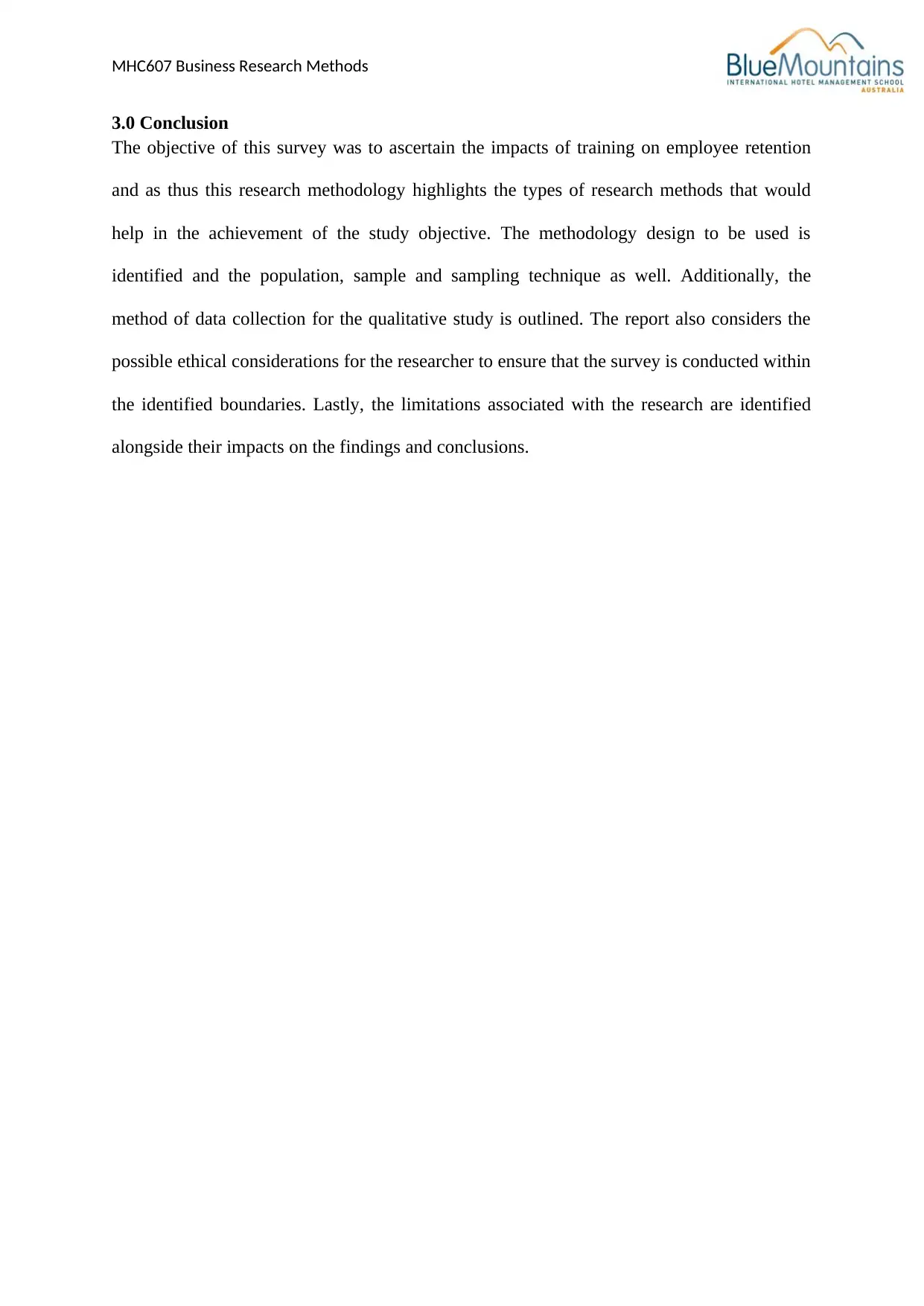
MHC607 Business Research Methods
3.0 Conclusion
The objective of this survey was to ascertain the impacts of training on employee retention
and as thus this research methodology highlights the types of research methods that would
help in the achievement of the study objective. The methodology design to be used is
identified and the population, sample and sampling technique as well. Additionally, the
method of data collection for the qualitative study is outlined. The report also considers the
possible ethical considerations for the researcher to ensure that the survey is conducted within
the identified boundaries. Lastly, the limitations associated with the research are identified
alongside their impacts on the findings and conclusions.
3.0 Conclusion
The objective of this survey was to ascertain the impacts of training on employee retention
and as thus this research methodology highlights the types of research methods that would
help in the achievement of the study objective. The methodology design to be used is
identified and the population, sample and sampling technique as well. Additionally, the
method of data collection for the qualitative study is outlined. The report also considers the
possible ethical considerations for the researcher to ensure that the survey is conducted within
the identified boundaries. Lastly, the limitations associated with the research are identified
alongside their impacts on the findings and conclusions.
⊘ This is a preview!⊘
Do you want full access?
Subscribe today to unlock all pages.

Trusted by 1+ million students worldwide
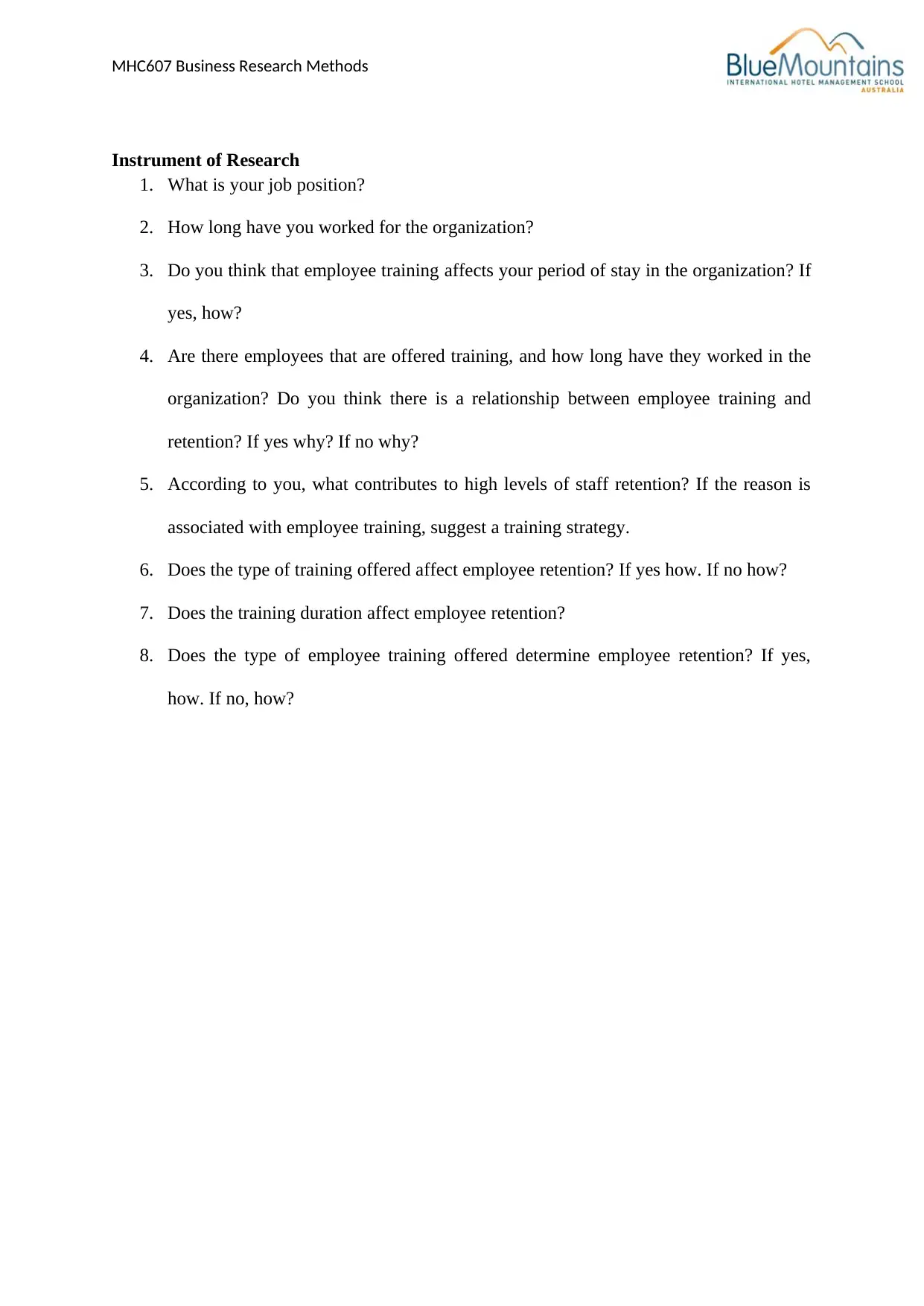
MHC607 Business Research Methods
Instrument of Research
1. What is your job position?
2. How long have you worked for the organization?
3. Do you think that employee training affects your period of stay in the organization? If
yes, how?
4. Are there employees that are offered training, and how long have they worked in the
organization? Do you think there is a relationship between employee training and
retention? If yes why? If no why?
5. According to you, what contributes to high levels of staff retention? If the reason is
associated with employee training, suggest a training strategy.
6. Does the type of training offered affect employee retention? If yes how. If no how?
7. Does the training duration affect employee retention?
8. Does the type of employee training offered determine employee retention? If yes,
how. If no, how?
Instrument of Research
1. What is your job position?
2. How long have you worked for the organization?
3. Do you think that employee training affects your period of stay in the organization? If
yes, how?
4. Are there employees that are offered training, and how long have they worked in the
organization? Do you think there is a relationship between employee training and
retention? If yes why? If no why?
5. According to you, what contributes to high levels of staff retention? If the reason is
associated with employee training, suggest a training strategy.
6. Does the type of training offered affect employee retention? If yes how. If no how?
7. Does the training duration affect employee retention?
8. Does the type of employee training offered determine employee retention? If yes,
how. If no, how?
1 out of 7
Related Documents
Your All-in-One AI-Powered Toolkit for Academic Success.
+13062052269
info@desklib.com
Available 24*7 on WhatsApp / Email
![[object Object]](/_next/static/media/star-bottom.7253800d.svg)
Unlock your academic potential
Copyright © 2020–2025 A2Z Services. All Rights Reserved. Developed and managed by ZUCOL.





